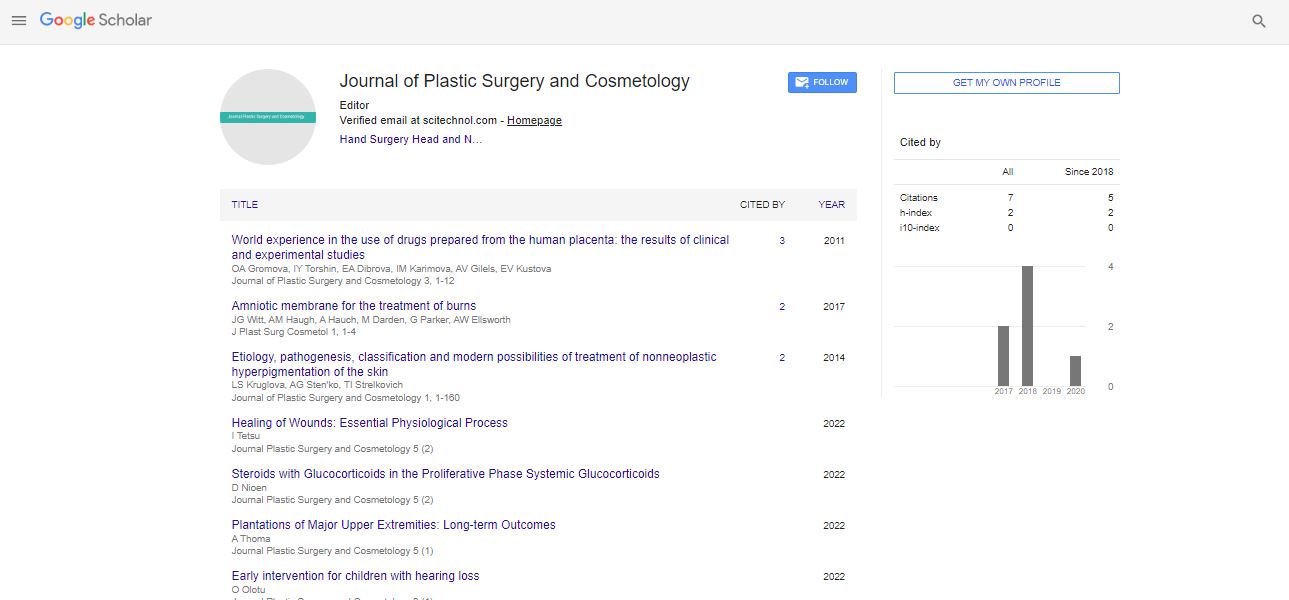Commentary, J Pls Sur Cos Vol: 12 Issue: 4
Advancements in Non-Surgical Aesthetic Enhancement: A Comprehensive Review of Injectables, Laser Treatments, and Radiofrequency Technologies
Pauliina Huges*
1Division of Plastic Surgery, Mayo Clinic, Jacksonville, United States of America
*Corresponding Author: Pauliina Huges,
Division of Plastic Surgery, Mayo Clinic,
Jacksonville, United States of America
E-mail: Hugespauliina5@gmail.com
Received date: 27 November, 2023, Manuscript No. JPSC-24-123953;
Editor assigned date: 29 November, 2023, Pre QC No. JPSC-24-123953 (PQ);
Reviewed date: 14 December, 2023, QC No. JPSC-24-123953;
Revised date: 21 December, 2023, Manuscript No. JPSC-24-123953 (R);
Published date: 28 December, 2023, DOI: 10.4172/JPSC.1000071
Citation: Huges P (2023) Advancements in Non-Surgical Aesthetic Enhancement: A Comprehensive Review of Injectables, Laser Treatments, and Radiofrequency Technologies. J Pls Sur Cos 12:4.
Description
The field of aesthetic enhancement has witnessed a paradigm shift with the emergence of advanced non-surgical options. In recent years, injectables, laser treatments, and radiofrequency technologies have gained prominence for their ability to achieve remarkable aesthetic results with minimal downtime. This essay reviews the latest developments in these non-surgical modalities, exploring their mechanisms of action, applications, and the evolving landscape of aesthetic medicine. Botulinum toxin, commonly known as Botox, remains a cornerstone in non-surgical aesthetic enhancement. Botox works by temporarily paralyzing muscle activity, reducing the appearance of dynamic wrinkles and fine lines. Its versatility makes it suitable for addressing concerns such as crow's feet, forehead lines, and frown lines. Recent advancements involve refined injection techniques, smaller doses, and strategic placement for more natural and customizable results.
Dermal fillers have evolved beyond simple wrinkle correction, now offering a spectrum of applications in facial volumization, contouring, and rejuvenation. Hyaluronic acid-based fillers, such as Juvederm and Restylane, provide hydration, restore volume, and improve skin elasticity. The latest generation of fillers incorporates innovative technologies, such as cross-linking methods, to extend longevity and enhance safety profiles.
Poly-L-Lactic Acid (PLLA) and Calcium Hydroxylapatite (CaHA) represent biostimulatory fillers that trigger collagen production, promoting natural-looking results over time. Sculptra, an injectable containing PLLA, stimulates collagen synthesis, resulting in gradual volume restoration. Similarly, CaHA-based fillers like Radiesse provide immediate volume and stimulate collagen for sustained benefits. These fillers cater to individuals seeking long-term improvements in facial contours and skin quality.
Beyond aesthetic applications, injectables are increasingly used to address functional concerns. Neurotoxins, primarily Botox, have gained FDA approval for treating hyperhidrosis (excessive sweating). Microinjections strategically placed in sweat-prone areas temporarily block nerve signals, providing relief from excessive perspiration. This innovative use demonstrates the expanding versatility of injectables in addressing both aesthetic and functional concerns. Fractional laser technology has revolutionized skin resurfacing by delivering precise microthermal zones of damage to the skin. This stimulates collagen production and promotes skin renewal. Fractional lasers are employed for addressing concerns such as fine lines, acne scars, and uneven skin texture. The latest advancements involve fractional lasers with adjustable settings, allowing for personalized treatment plans tailored to individual skin types and concerns.
Intense Pulsed Light (IPL) technology uses broad-spectrum light to target pigment irregularities, vascular lesions, and photodamaged skin. IPL treatments are versatile, addressing conditions like sunspots, rosacea, and broken capillaries. Recent developments include optimized IPL devices with enhanced efficacy and minimal downtime. These innovations cater to individuals seeking non-invasive solutions for pigmentation and vascular concerns.
Non-ablative lasers, such as fractional non-ablative lasers, stimulate collagen production without causing significant surface damage. Ablative lasers, on the other hand, remove layers of skin to address more pronounced concerns like deep wrinkles and scars. Hybrid fractional lasers, combining both non-ablative and ablative components, offer a balanced approach for comprehensive skin rejuvenation. These technologies provide tailored solutions for individuals with varying degrees of skin aging. Picosecond lasers represent a breakthrough in tattoo removal and skin rejuvenation. These lasers emit ultra-short pulses, measured in picoseconds, allowing for faster and more efficient removal of tattoo pigments. Additionally, picosecond lasers target pigmentation concerns and stimulate collagen production for skin revitalization. Their precision and reduced thermal damage contribute to shorter recovery times and improved patient satisfaction.
Radiofrequency (RF) Technologies are binding microneedling with radiofrequency, RF microneedling delivers controlled thermal energy to the dermis, stimulating collagen and elastin production. This dualaction approach addresses concerns like wrinkles, sagging skin, and acne scars. The latest RF microneedling devices feature adjustable depths and energy levels, allowing for precise customization based on the treatment area and individual skin characteristics. Non-invasive RF devices for skin tightening have gained popularity for their ability to improve skin laxity without surgery. These devices deliver RF energy to the skin's deep layers, promoting collagen contraction and remodeling. Innovations in non-invasive RF technologies include improved energy delivery mechanisms and real-time temperature monitoring, ensuring both safety and efficacy in skin tightening procedures. Fractional RF treatments combine the benefits of fractional technology with radiofrequency energy. This approach targets a fraction of the skin's surface while delivering RF energy to deeper layers. Fractional RF is effective in addressing concerns like fine lines, enlarged pores, and acne scars. Ongoing advancements involve refining the fractionation patterns and optimizing energy delivery for enhanced results with minimal downtime. The integration of injectables, laser treatments, and RF technologies has paved the way for multimodal approaches to aesthetic enhancement.
 Spanish
Spanish  Chinese
Chinese  Russian
Russian  German
German  French
French  Japanese
Japanese  Portuguese
Portuguese  Hindi
Hindi 